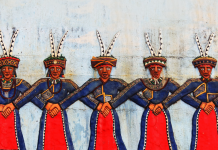Asia’s classic mode of transport has seen continuous upgrades over the years. Yet the earliest rickshaws – and the downtrodden coolies that pulled them – may soon be relics of history following Kolkata’s efforts to eradicate them
The pulled rickshaw – a two-wheeled passenger vehicle powered by the strength of a barefoot rickshaw coolie – is a predominant symbol of Asia in the 1900s. Used to carry goods and people around cities, these early forms of transport often provided migrants from rural villages a prime source of employment, and the wealthy a convenient mode of getting around town before buses and trains were invented.
Rickshaw coolies rented their vehicles, and would eat and sleep in them to prevent them from being stolen. They toiled long hours for little reward, using their arms and upper body to pull passengers along (at speeds of about 8km/h) amid mud, grime and flooded streets. Films and books like City of Joy, Do Bigha Zamin and Rickshaw Boy chronicle the stories of a rickshaw coolie’s intense physical exertion.
Over the years, the pulled rickshaw saw some upgrades – rubber tyres, lights, backrests, and spring cushions – but changes often resulted in coolies going on strike over higher rental fees for upgraded models. Attempts to motorise the rickshaw were also met with fierce resistance, as coolies feared the loss of their jobs. Nevertheless, concern about coolies’ welfare resulted in pulled rickshaws being banned across Asia, starting with Singapore in 1947.
Today, most hand-pulled rickshaw rides are solely for tourists. The Indian city of Kolkata is one of the last places rickshaws still provide a service to loyal customers, who prize them for their ability to navigate narrow lanes easily and operate even during the monsoon season. But even the future of this last rickshaw frontier is contested.
In 2005, the Kolkata Municipal Corporation attempted to put an end to the trade by stopping license renewals and confiscating illegal vehicles. However, pulled rickshaws continued to ply the streets, and in 2011, authorities decided to release 6,000 licences to provide jobs for elderly rickshaw pullers with no alternative skills. Over the last few years, the government has been considering replacing pulled rickshaws with low-emissions electric versions, claiming that battery-operated rickshaws would help coolies get better business, but legislation has failed to materialise.
For now, the pulled rickshaw remains a fixture of Kolkata’s streets, a vestige of colonialism that refuses to fade away.
Related: Thailand’s Hill Tribes See Their Last Days
Related: No Land For Nomads
Related: Vanishing Roots
For more stories and photographs from this issue, see Asian Geographic Issue 129, 2018




![The Road to Independence: Malaya’s Battle Against Communism [1948-1960]](https://asiangeo.com/wp-content/uploads/2021/07/WhatsApp-Image-2021-07-26-at-11.07.56-AM-218x150.jpeg)






